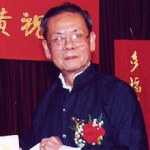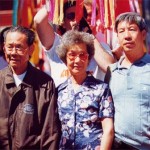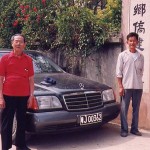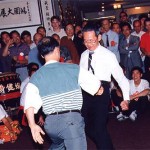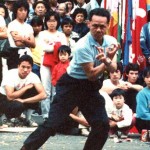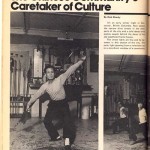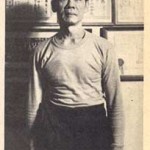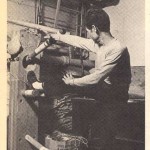|
|
We the instructors of this school owe our entire martial arts careers to our teacher, Grandmaster Wong Ha, who passed away on June 13, 2007. This section is dedicated to his story – how he started out in kungfu, his experiences in China, Hong Kong, and finally how he came to Canada and established himself as one of Vancouver’s respected martial arts elders.His life spans well over 8 decades and two continents — just talking to him about his past is a great history lesson in itself! We made two 3-week long trips to China and Hong Kong with our teacher, and we found that he was the best tour guide one could possibly find there — there was little throughout our travels that he had not seen or experienced already. And did we mention that he is also a renowned Chinese chef?
His Beginnings At the tender age of 15, Grandmaster Wong Ha started working to help support his family in rural Guangdong, China, washing dishes and doing odd jobs in a restaurant. As the hours in a restaurant involved split shifts, most restaurant workers enjoyed gambling to pass the time in between work. Instead of following suit, he decided to take up lessons in kungfu. It became an important part of his life, and in fact was willing to spend a third of his entire income to pay for lessons. Choy Lai Fut’s founder’s grandson, Chan Yiu Chi, had opened up a school in the city of Guangzhou, and that is where our teacher studied the art for the next decade and more. Not only did his skills in martial arts improve over the years, he also picked up a second interest that complemented the kungfu — Chinese herbal medicine and Dit Da joint manipulation techniques. Even during World War II, although life was difficult and times were tough for everyone around him, still he managed to maintain his skills. After the war was over and China drifted into a more peaceful, rebuilding state, he settled back into the Guangdong and Hong Kong areas, often travelling back and forth depending on where work was to be found. He and his kungfu brothers would meet on a monthly basis, and pool whatever money they could to buy food to send back to the village where his Sifu Chan Yiu Chi lived. While in Hong Kong, he began teaching Choy Lai Fut. Fast Forward…to Canada In 1966, he was sponsored over to Vancouver, Canada by the Beachcombers restaurant to work as one of their chefs. While working in the restaurant, some of the other Chinese workers there discovered that he was skilled in kung fu — and so his teaching career in Vancouver began. For about 10 years, he taught at the Hon Hsing Athletic Association in Chinatown, and in the meantime also taught at various other associations before settling into his own private school on Powell Street. Not long after that, he relocated a few blocks away to Jackson Street in 1973. Over four decades, he taught over a thousand students the art of Choy Lai Fut. He remained ever faithful to the ancestors of the style, and every year until his death he actively organized the 700-person annual celebration in honour of the Choy Lai Fut founder and his descendants. Not for a day did he stop training – he was still as spry and active as ever in his 80s. It is hard to believe, but he had the energy and feistiness of a man half his age. He often went down to his school to watch the students practice, and quite often gives pointers on how to improve. He was truly a remarkable man, and had the generosity and kindness to match his energy and youthfulness. Wong Ha has been like a father to us, and here on this website we want to express our deepest gratitude and respect for everything he has taught and done for us. |
||
Choy Lai Fut Martial Arts Hall
A traditional kungfu school based in Richmond, BC, Canada. Classes taught by two female instructors.
Business Hours & Contact
Call us at 604-231-9056 during business hours:
Tuesdays: 5:30 – 9:00 pm
Thursdays: 5:30 – 9:00 pm
Saturdays: 10:30 am to 5:00 pm
Outside of business hours, you can leave us a voice message and we'll respond as quickly as possible. Or better yet, drop us a line at info@choylaifut.com.
How to find us
Pacific Plaza (ground floor)
Unit 1005, 8888 Odlin Crescent
Richmond, BC, Canada
我們位於太古廣場﹐列治文 Garden City 夾 Cambie 路口。您在停車場的入口處就可以看到我們( Unit 1005 )﹐就在拐角處。
Archives by category
- Events (10)
- General updates (3)
- Schedule and classes (5)
- Student updates (9)
- Uncategorized (2)
Student Fees
Contact us at info@choylaifut.com and we'll be happy to give you more info about our fees.
Lion dance performances
Interested in having a traditional Chinese lion dance performance for your wedding, business opening, or other special event?
Please contact us for availability and more information.
Copyright © 2025 · Genesis Framework · WordPress · Log in
